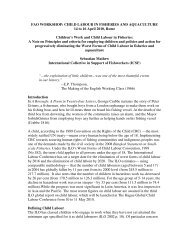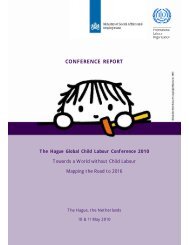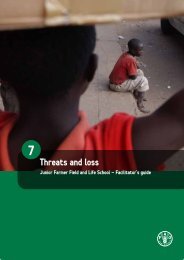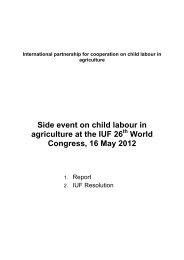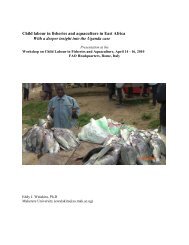Mainstreaming responses to the girl child in agriculture - Food ...
Mainstreaming responses to the girl child in agriculture - Food ...
Mainstreaming responses to the girl child in agriculture - Food ...
You also want an ePaper? Increase the reach of your titles
YUMPU automatically turns print PDFs into web optimized ePapers that Google loves.
The ma<strong>in</strong> tasks performed by <strong>the</strong> <strong>child</strong>ren were pick<strong>in</strong>g coffee berries, prun<strong>in</strong>g, weed<strong>in</strong>g<br />
and pesticide spray<strong>in</strong>g, without any protective cloth<strong>in</strong>g or equipment. Some <strong>child</strong>ren<br />
sprayed pesticides for three hours per day on average. The <strong>child</strong>ren were exposed <strong>to</strong><br />
<strong>to</strong>ugh and strenuous activities irrespective of <strong>the</strong>ir age. O<strong>the</strong>r hazards <strong>in</strong>cluded snake<br />
and <strong>in</strong>sect bites, and attacks by wild animals. Children worked on average between<br />
eight and 10 hours per day, depend<strong>in</strong>g on <strong>the</strong> season.<br />
An ILO IPEC basel<strong>in</strong>e survey <strong>in</strong> three tea grow<strong>in</strong>g districts - Korogwe, Lusho<strong>to</strong>,<br />
Muheza – <strong>in</strong> Tanzania concluded that hazardous <strong>child</strong> labour existed both on small and<br />
large-scale tea grow<strong>in</strong>g farms (plantations). Most of <strong>the</strong> 1,000 <strong>child</strong>ren <strong>in</strong> <strong>the</strong> study were<br />
11-14 years old, with <strong>girl</strong>s <strong>in</strong> <strong>the</strong> majority. The <strong>child</strong>ren <strong>in</strong>terviewed were engaged <strong>in</strong><br />
pluck<strong>in</strong>g and carry<strong>in</strong>g <strong>the</strong> tea leaves. They worked on average eight hours per day,<br />
usually without a lunch break as <strong>the</strong>y cont<strong>in</strong>ued pluck<strong>in</strong>g <strong>to</strong> earn more money (ILO,<br />
2002).<br />
3.4 Girls bear <strong>the</strong> burden of domestic work<br />
From a gender perspective, one of <strong>the</strong> key issues not fully addressed <strong>in</strong> many studies<br />
cover<strong>in</strong>g <strong>girl</strong> <strong>child</strong> labour <strong>in</strong> <strong>agriculture</strong> is how <strong>girl</strong>s comb<strong>in</strong>e work <strong>in</strong> <strong>agriculture</strong> with<br />
domestic chores (ILO, 2006c). By mimick<strong>in</strong>g and support<strong>in</strong>g <strong>the</strong> roles of <strong>the</strong>ir mo<strong>the</strong>rs<br />
or female relatives, <strong>girl</strong>s take on more domestic tasks than boys, along with agricultural<br />
tasks – <strong>the</strong>refore for <strong>girl</strong>s <strong>the</strong>re is <strong>the</strong> danger of a double burden <strong>in</strong> agricultural societies,<br />
which negatively impacts on <strong>the</strong>ir education possibilities. In households with a large<br />
number of younger sibl<strong>in</strong>gs, <strong>girl</strong>s from <strong>the</strong> age of 5 years often care for <strong>the</strong>ir younger<br />
sibl<strong>in</strong>gs so <strong>the</strong>ir mo<strong>the</strong>rs can work.<br />
The Tanzanian trade union, <strong>the</strong> Conservation, Hotels, Domestic and Allied<br />
Workers’ Union (CHODAWU), has found that <strong>the</strong> types of work carried out by <strong>child</strong><br />
domestic workers <strong>in</strong> rural areas typically <strong>in</strong>clude wash<strong>in</strong>g clo<strong>the</strong>s, dishes, babysitt<strong>in</strong>g,<br />
fetch<strong>in</strong>g water, collect<strong>in</strong>g firewood, garden<strong>in</strong>g, tak<strong>in</strong>g care of poultry and animals on<br />
<strong>the</strong> premises, (<strong>in</strong>clud<strong>in</strong>g milk<strong>in</strong>g cows) and harvest<strong>in</strong>g crops. In o<strong>the</strong>r words, <strong>child</strong><br />
domestic workers frequently carry out agricultural tasks as part of <strong>the</strong>ir "domestic"<br />
duties 16 .<br />
In Nepal, under <strong>the</strong> Kamalhari practice of bonded labour, 8-16 year-old <strong>girl</strong>s of <strong>the</strong><br />
Kamaiya worked <strong>in</strong> <strong>the</strong> house of <strong>the</strong>ir landlords as domestic servants. Some of <strong>the</strong><br />
"domestic" duties <strong>in</strong>volved agricultural activities, such as collect<strong>in</strong>g grass for cattle,<br />
clean<strong>in</strong>g out cowsheds, tak<strong>in</strong>g care of lives<strong>to</strong>ck and so on. Follow<strong>in</strong>g <strong>the</strong> Bonded<br />
Labour Prohibition Act, 2001, <strong>the</strong> Kamaiyas were legally free from <strong>the</strong> landlords.<br />
However, many Kamaiyas became homeless as a result with no stable source of <strong>in</strong>come<br />
after <strong>the</strong>ir freedom. Some resorted <strong>to</strong> earn<strong>in</strong>g a liv<strong>in</strong>g through sharecropp<strong>in</strong>g<br />
arrangements with <strong>the</strong>ir former landlords, receiv<strong>in</strong>g land for sharecropp<strong>in</strong>g <strong>in</strong> return for<br />
agree<strong>in</strong>g that <strong>the</strong>ir <strong>child</strong>ren work as domestic servants <strong>in</strong> <strong>the</strong>ir landlords' houses 17 .<br />
The cus<strong>to</strong>m of <strong>child</strong>ren on farms comb<strong>in</strong><strong>in</strong>g domestic and agricultural chores<br />
appears <strong>to</strong> have consequences beyond <strong>the</strong> farm as well. Child domestic labour <strong>in</strong> urban<br />
areas is, <strong>in</strong> many cases, <strong>the</strong> result of migration from <strong>the</strong> rural areas <strong>to</strong> <strong>the</strong> cities. Girls<br />
who work as domestics <strong>in</strong> urban areas often come from farm<strong>in</strong>g families. For example,<br />
U. Murray, P. Hurst - Draft for discussion - 10






